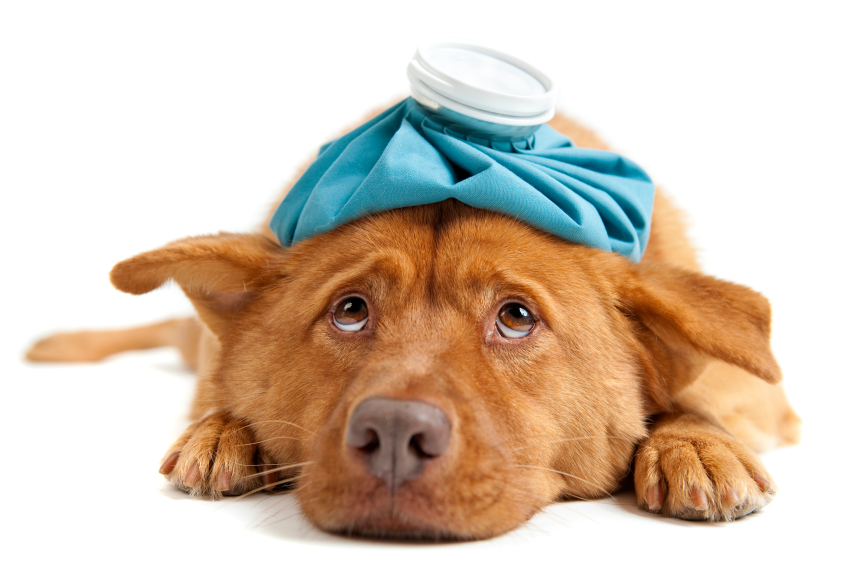If you’ve ever experienced the heartache of watching your pooch struggle with the itching and pain of a yeast infection in one or both of his ears, you can understand the frustration dog owners feel in trying to find a way to cure the problem.
Both of our German Shepherds are prone to yeast infections, and no matter how often we cleaned their ears, they seemed to only get relief for a few days before the head shaking and pawing at their ears started again.
Finally, after searching for a solution for months, we found the remedy that worked! I’ll detail for you how to treat yeast infections in your dog’s ears in a way that worked for us.
What is a Yeast Infection and How Do You Know if Your Dog Has One?
 It is normal for yeast to be present in your dog’s ear, but a yeast infection is an overgrowth of yeast that causes itching, scabs, and a waxy substance in the ear. Shaking their head back and forth and scratching their ear can be signs that an infection has started.
It is normal for yeast to be present in your dog’s ear, but a yeast infection is an overgrowth of yeast that causes itching, scabs, and a waxy substance in the ear. Shaking their head back and forth and scratching their ear can be signs that an infection has started.
Always see your veterinarian to diagnose any problems with your dog’s ears. Some other problems that can be present with or without a yeast infection can be:
- A ruptured ear drum
- An object embedded in the ear canal or a growth, such as a polyp
- Allergies
- An infection caused by bacteria
Once a veterinarian has diagnosed the problem as a yeast infection and showed the best way to keep the ear clean, hopefully that solves the problem. Unfortunately, that wasn’t the case for us.
Our Story
 Sasha began having yeast infections first, and our vet expected her to be prone to them due to her extremely long ear canals. At first cleaning her ears once a week worked fairly well.
Sasha began having yeast infections first, and our vet expected her to be prone to them due to her extremely long ear canals. At first cleaning her ears once a week worked fairly well.
But as she kept having them, the vet started her on probiotics to see if the change in her body chemistry would help, it didn’t.
Tahlen began having problems in one of his ears, and we weren’t any more successful in keeping his ears clear either.
Everything got worse one day when they both tangled with a big raccoon that had gotten through the fence on our property. Both of them ended up with some cuts that we needed to see our vet for and they had to take antibiotics.
While the antibiotics were very needed, they basically killed all the good bacteria in their ears along with the bad bacteria. This allowed the yeast to thrive, resulting in a very itchy, painful infection for both of them right as the Thanksgiving holiday weekend started.
They needed relief and they needed it now!
==>==> See how CBD Oil can help with your Dog’s Mobility, Pain, Anxiety, and more <==<==
This Remedy Worked!
I’d heard of several different remedies, with mixed results, but one that made sense to me was using a medicine specifically made for yeast infections in women–Miconazole, or Monistat 7
.
But our dog’s infection was deep in their ears, and I wasn’t comfortable trying to rub a cream deep enough to be effective without possibly injuring their ears.
I had to be able to thin it out and apply it so that it would flow deep into the ear canal. Since I knew they’d shake their ears as soon as I put the medicine in it, my hope was that this would distribute the medicine around the inner part of their ears.
So I put about a pea sized amount of the Monistat in a very small glass bowl. Since they desperately needed relief from the itching, I also added the same amount of cortisone anti-itch creme.
Then I added about 2 ml of water to thin it out. The mixture would not mix well, so I put it in the microwave for just a few seconds, about 8 seconds. That worked!
I had a liquid that easily filled an eye dropper and put about 1 ml in one of Sasha’s ears and rubbed her ear a little bit before letting her shake her head around. I put the medicine in her other ear, mixed up a new batch, and treated Tahlen’s ears.
==>==> See our reviews of 8 Orthopedic Dog Beds worth your money today <==<==
The Results?
Within an hour, I could see the difference! Both of them were sleeping soundly (something none of us had done for a couple of nights!)
 I treated them with this remedy for 2 weeks, once a day, with phenomenal results! After almost 4 months, they are still infection free and feeling wonderful!
I treated them with this remedy for 2 weeks, once a day, with phenomenal results! After almost 4 months, they are still infection free and feeling wonderful!
If the yeast infection comes back, or if they have to go on another round of antibiotics, I have the peace of mind that I can start treating them quickly and save them from hours, if not days, of the painful itching of this condition.
After the vet verified that the yeast infection was gone, she did recommend cleaning their ears once a week to help prevent it from reoccurring. The product she recommended was Oti-Clens, and I believe it has been helpful.
So if you are struggling with how to treat yeast infections in your dog’s ears, try this method and let me know if it works for you as well as it did for Sasha and Tahlen.
And if you have another method that worked for your pooch, let me know in the comments below!
***Update***
 I have an update on this remedy! Sasha wound up having to have a 2nd surgery on her leg and was on antibiotics for a month. Of course, this started up another yeast infection in her ears.
I have an update on this remedy! Sasha wound up having to have a 2nd surgery on her leg and was on antibiotics for a month. Of course, this started up another yeast infection in her ears.
I used this remedy again as soon as she started shaking her head and got the same results as the first time. She’s doing great–I’m happy to report that the remedy was effective!
***2nd Update***
Well, it’s been almost 2 years since I first published this post, so I wanted to give an update on how well this treatment has been working.
Sasha has gotten a yeast infection in her ears about once every 8 months or so. Each time we give her this remedy for about 2 weeks, and it clears up just fine.
Now that we know the signs to look for that tell us she’s in discomfort, we can start clearing it up faster, and she doesn’t go through the painful experience that she’s had before.
I’m also happy to report that Tahlen has not gotten another yeast infection in his ears (yay!), but he’s very happy to still share in the special treat that we give to Sasha when she gets treated!
Remember what we say here at Love My Pooches…..








Goodness yeast infection is sure one stubborn medical ailment that is hard to get rid of. We have been very fortunate with our family dog. Luckily she hasn’t suffered from it yet. Thanks for writing such an excellent guide how to treat yeast infection. This will surely be helpful.
Is this remedy safe to use on cats as well?
Theresa
It’s great that your dog hasn’t had any sort of yeast infection in her ears! I have no experience on using this type of treatment on cats. If a cat starts having ear problems, your vet could probably look at this remedy to see if could be tried on her. But I would definitely consult the vet before trying any type of treatment so you know exactly what kind of ear problem you’re dealing with.
Hi there Janelle,
Thank you kindly for creating and sharing this informative article regarding yeast infection in our pooches ears with us all, it is really appreciated, thanks.
treatment is one thing, and yeast being absolutely normal in a dog ear (but not to the point of infection!) my question is do you have any tips, tricks and techniques to help prevent a yeast infection or any help to prevent recurring yeast infections?
I discussed prevention with our dog’s vet, and she stated that cleaning their ears on a regular basis with a product such as Oti-Clens could definitely help. So we’ve been doing that once a week, and I think it is helping to prevent the infection from reocurring as often.
Both of our dogs have extremely long ear canals, so unfortunately, they will be susceptible to yeast infections more than some. I’m just so glad to have a remedy that works when it happens!
Hi
Yes i have watched my poor dog shake and scratch her ears, at first i thought maybe an ant got in there as we are suffering with ants at the moment, but as a couple of days went past i really couldn’t let her go on with this anymore so we went to the vet and yes a yeast infection:(
I have been searching for info on this subject and came across your post:) you have given some good information and i will deffo use your remedy if it returns.
Is there normally a smell from the ear if it is a yeast infection?
Thanks.
Your poor dog, I hope she gets better soon! As far as odor goes, there was a mild one with each of the dogs. But ours go outside and run in the creek and roll on everything imaginable. So they’re usually shaking their ears before I notice any odor that would give me a clue about a yeast infection.
Thanks for stopping by!
Amazing what it took to get them better. Something the vast majority of us would never had thought of that. Great story that may help many. Thanks!
I definitely hope it helps anyone whose dog is suffering from an ear infection, thanks Thomas!
We have been luck that our Abby has not had any yeast infections in her ears. If happens to have them and the Vet cannot help we will try this remedy. Who would have thought that these few ingredients would do the trick. Thanks for the post.
Allan
You’re welcome!
The only ear problems any of my dogs ever had was from allergies or from ear mites. As bad as those situations were, I can’t imagine how bad a yeast infection must bother their ears. Poor pups. Thank you for this information.
Glad to hear they aren’t prone to yeast infections! Thank you!
I just went through this with my Cowboy, He had a yeast infection in one ear and bacterial in the other.
have been to the vet twice, as of right now things are mellow but at the first sign i will try this, I have had to deal with this for the first time.
I know my little Cowboy was miserable for a few weeks before I figured out what was going on. I cleaned his ears trying to make sure they stayed clean and within a couple days he was scratching at his poor ears again. That was it to the vet we go. They fixed him up.
If I would have know about this I would have tried it when it first began and maybe it would not have gotten so bad.
Thank You for the experiment that worked and keep me updated with your blog.
You definitely know what a poor dog goes through with a yeast infection, glad it was cleared up! If it reoccurs and you use my remedy, I’d love to hear the results!